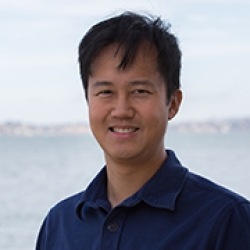
Andy Chang
Biography
I lead the team of scientists in the Tiburon, California section of the Smithsonian Environmental Research Center's Marine Invasions Research Lab. Our lab has been based at the Estuary & Ocean Science Center since 2000.
My research examines how geographic patterns of diversity in estuarine and coastal systems are controlled by environmental drivers and biotic interactions. Estuaries are extraordinarily dynamic and often highly impacted, and serve as terrific laboratories for understanding human influences on coastal ecosystems. The natural physical and biotic gradients in estuaries also afford a good opportunity to test fundamental ecological theories about the factors that control species diversity, abundance, and ecosystem functioning.
With colleagues in the Marine Invasions Lab, I use models, field surveys, and manipulative field and lab experiments to study the ways species and communities respond to environmental changes and invasions by non-native species. This work includes several long-term studies of the San Francisco Bay estuary and the California coast with a particular focus on the influence of freshwater flow and temperature variation on marine invertebrate community assembly, biogeography, invasion patterns, and native oyster population dynamics. Ongoing work includes surveys of California waters for non-native species and collaborative projects with the San Francisco Bay National Estuarine Research Reserve to assess the conditions promoting sustainable oyster populations.
Selected Publications
- Cheng BS, Blumenthal JG, Chang AL, Barley J, Nielsen KJ, Ruiz GM, and CJ Zabin (2021) Severe invasive predator impacts on native oysters despite attempted functional eradication. Biological Invasions. DOI: 10.1007/s10530-021-02677-3
- Grosholz ED, Ashton G, Bradley M, Ceballos L, Chang AL, deRivera C, Gonzalez J, Heineke M, Maraffini M, McCann L, Pollard E, Pritchard I, Ruiz G, Tepolt C (2021) Dramatic Population Irruption Defeats Eradication of an Invasive Marine Predator. Proc Nat Acad Sci USA. DOI: 10.1073/pnas.2003955118
- Edmiston CE, Cochlan W, Ikeda CE, and AL Chang (2021) Impacts of a temperate to tropical voyage on the microalgal hull fouling community of an atypically-operated vessel. Marine Pollution Bulletin 165: 112112. DOI: 10.1016/j.marpolbul.2021.112112
- Chang AL, Carlton JT, Brown CW, Ruiz GM (2020) Down the up staircase: Equatorward march of a cold-water ascidian and broader implications for invasion biology. Diversity and Distributions. DOI: 10.1111/ddi.13055
- Jimenez H, Chang AL, Ruiz GM (2019) Consistent geographic patterns in soft-sediment community composition along an estuarine gradient. Estuarine, Coastal and Shelf Science 227: 106324. DOI: 10.1016/j.ecss.2019.106324
- Newcomer KA, Tracy B, Chang AL, and GM Ruiz (2019) Evaluating performance of photographs for marine citizen science applications. Frontiers in Marine Science. 6:336. DOI: 10.3389/fmars.2019.00336
- Newcomer KA, Marraffini ML, and AL Chang (2018) Distribution patterns of an introduced encrusting bryozoan, Conopeum chesapeakensis (Banta, Perez and Santagata, 1995) in an estuarine environment in upper San Francisco Bay. Journal of Experimental Marine Biology and Ecology 504: 20–31.
- Chang AL, Brown CW, Crooks JA, and GM Ruiz (2018). Dry and wet periods drive rapid shifts in community assembly in an estuarine ecosystem. Global Change Biology. DOI: 10.1111/gcb.13972
- Marraffini ML, Brown CW, Ashton G, Chang AL, and GM Ruiz (2017) Do settlement plates effectively sample established fouling communities for non-indigenous species? Management of Biological Invasions.
- Jimenez H, Keppel E, Chang AL, Ruiz GM (2017) Invasions in marine communities: contrasting patterns of species richness and community composition across habitats and salinity. Estuaries and Coasts. DOI: 10.1007/s12237-017-0292-4
- Bible J, Cheng BS, Chang AL, Ferner MC, Wasson K, Zabin CJ, Latta M, Sanford E, Deck A, Grosholz ED (2017) Timing of climate-driven stressors alters interactive effects on a coastal foundation species. Ecology. DOI: 10.1002/ecy.1943
- Tracy B, Larson K, Ashton G, Lambert G, Chang AL, and GM Ruiz (2017) Northward range expansion of three non-native ascidians on the west coast of North America. BioInvasions Records.
- Chang AL, Deck AK, Sullivan LJ, Morgan SG, and MC Ferner (2016) Upstream – downstream shifts in a recruitment hotspot of the native Olympia oyster in San Francisco Bay during wet and dry years. Estuaries and Coasts. DOI: 10.1007/s12237-016-0182-1
- Cheng BS, Chang AL, Deck A, Ferner MC (2016) Extreme low salinity drives mass mortality in northern San Francisco Bay: a consequence of atmospheric rivers? Proceedings of the Royal Society B 283: 20161462. DOI: 10.1098/rspb.2016.1462
- Wasson K, Hughes B, Berriman J, Chang A, Deck A, Dinnel P, Endris C, Espinoza M, Dudas S, Ferner M, Grosholz E, Kimbro D, Ruesink J, Trimble A, Vander Schaaf D, Zabin C, Zacherl D (2016) Coast-wide recruitment dynamics of Olympia oysters reveal limited synchrony and multiple predictors of failure. Ecology. DOI: 10.1002/ecy.1602
- Crooks JA, Chang AL, Ruiz GM (2016) Decoupling the response of an estuarine shrimp to architectural components of habitat structure. PeerJ 4: e2244.